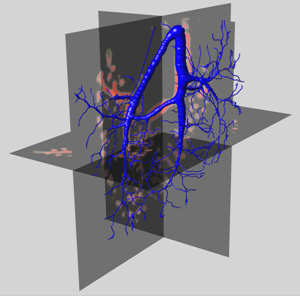Jul 14 2014
Researchers have pioneered a revolutionary new way to digitally navigate three-dimensional images. The new technology, called Virtual Finger, allows scientists to move through digital images of small structures like neurons and synapses using the flat surface of their computer screens.
Virtual Finger’s unique technology makes 3D imaging studies orders of magnitude more efficient, saving time, money and resources at an unprecedented level across many areas of experimental biology. The software and its applications are profiled in this week’s issue of the journal Nature Communications.

Most other image analysis software works by dividing a three-dimensional image into a series of thin slices, each of which can be viewed like a flat image on a computer screen. To study three-dimensional structures, scientists sift through the slices one at a time: a technique that is increasingly challenging with the advent of big data. “Looking through 3D image data one flat slice at a time is simply not efficient, especially when we are dealing with terabytes of data,” explains Hanchuan Peng, Associate Investigator at the Allen Institute for Brain Science. “This is similar to looking through a glass window and seeing objects outside, but not being able to manipulate them because of the physical barrier.”
In sharp contrast, Virtual Finger allows scientists to digitally reach into three-dimensional images of small objects like single cells to access the information they need much more quickly and intuitively. “When you move your cursor along the flat screen of your computer, our software recognizes whether you are pointing to an object that is near, far, or somewhere in between, and allows you to analyze it in depth without having to sift through many two-dimensional images to reach it,” explains Peng.
Scientists at the Allen Institute are already using Virtual Finger to improve their detection of spikes from individual cells, and to better model the morphological structures of neurons. But Virtual Finger promises to be a game-changer for many biological experiments and methods of data analysis, even beyond neuroscience. In their Nature Communications article, the collaborative group of scientists describes how the technology has already been applied to perform three-dimensional microsurgery in order to knock out single cells, study the developing lung, and create a map of all the neural connections in the fly brain.
Virtual Finger
“Using Virtual Finger could make data collection and analysis ten to 100 times faster, depending on the experiment,” says Peng. “The software allows us to navigate large amounts of biological data in the same way that Google Earth allows you to navigate the world. It truly is a revolutionary technology for many different applications within biological science,” says Peng.
Hanchuan Peng began developing Virtual Finger while at the Howard Hughes Medical Institute’s Janelia Research Campus and continued development at the Allen Institute for Brain Science.
About the Allen Institute for Brain Science
The Allen Institute for Brain Science is an independent, 501(c)(3) nonprofit medical research organization dedicated to accelerating the understanding of how the human brain works in health and disease. Using a big science approach, the Allen Institute generates useful public resources used by researchers and organizations around the globe, drives technological and analytical advances, and discovers fundamental brain properties through integration of experiments, modeling and theory. Launched in 2003 with a seed contribution from founder and philanthropist Paul G. Allen, the Allen Institute is supported by a diversity of government, foundation and private funds to enable its projects. Given the Institute’s achievements, Mr. Allen committed an additional $300 million in 2012 for the first four years of a ten-year plan to further propel and expand the Institute’s scientific programs, bringing his total commitment to date to $500 million. The Allen Institute’s data and tools are publicly available online at www.brain-map.org.